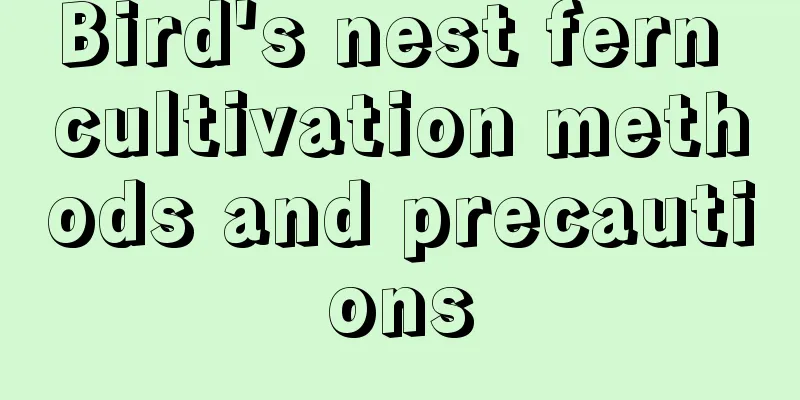Bird's nest fern cultivation methods and precautions

1. Maintenance methods1. Temperature: 16 to 27 degrees is most suitable for the growth of bird's nest fern. Too much heat or too much cold can be harmful to it. Therefore, try not to keep the temperature above 30 degrees in summer, otherwise its growth will slow down. In winter, try to keep the temperature around ten degrees. 2. Light: Wild bird's nest ferns grow in relatively shady places, so they do not require much light. Because, under normal circumstances, you can put it in a semi-shaded place. As long as there is a little astigmatism, it can meet its growth requirements. In summer, the shading degree needs to be controlled at about 70%, and there must be no strong light. 3. Watering: Bird's nest fern likes moisture very much, and a humid environment is suitable for its growth. When it grows fast, the substrate needs to be kept moist at all times. In winter, although its water requirement is reduced, it cannot be completely stopped. Spraying water can also be used instead of watering. 4. Fertilization: When the plant is growing fast, fertilize once every half a month, using mostly compound fertilizer. In extremely cold or hot weather, fertilization should be suspended. 2. Breeding techniques1. Repot; try to do it once a year. Take place in spring. You can choose leaf mold or peat soil, and add vermiculite, river sand, etc. Humus soil also works well. After choosing, remove the plant from the pot, repair the root system as needed, then replace the soil with new one and put the plant back into the pot. 2. Reproduction: Division is commonly used. Do it in mid or late April. A plant with vigorous growth should be used as the mother plant. When dividing the plants, do not divide the plants in too many quantities, and each plant should have enough roots. Leaf mold can be used as a substrate. After planting, keep the temperature at around 25 degrees and not too humid, otherwise the roots will rot easily. 3. Problem diagnosis and treatment1. Disease: Anthracnose often occurs, especially in summer. The leaves are mostly affected and some spots will appear. Methyl thiophanate can be used for prevention and control, once every ten days, for three to four times. 2. Pests: Mainly "nematodes", which can also cause some spots on the leaves. They can be controlled with furadan and other drugs. IV. Other issues1. Toxicity: It is non-toxic and has very high purification properties. 2. Can it be raised at home?: Doing so has many benefits, so it is more appropriate. It not only purifies the air, but is also an ornamental plant. |
<<: A complete guide to the cultivation methods and precautions of Araucaria
>>: The growth process of a tree
Recommend
Rapeseed planting time and method planting technology and field management
Rapeseed planting time There are two planting tim...
Plant a pot of onions at home, they are delicious and can prevent colds
How to Plant Onions Planting sprouted onions Peop...
When and how to plant pig ear beans
Planting time of pig ear beans Pig ear beans can ...
The efficacy and function of Prunella vulgaris
After being dried, Prunella Vulgaris is very ligh...
Can Nandina domestica be grown indoors?
1. Notes First of all, I want to tell you that Na...
How big can succulents grow?
1. How big can it grow? When caring for succulent...
Petunia planting and maintenance methods
Preparation The main preparation work includes: s...
Don’t buy fertilizers anymore. If you use these kitchen wastes to grow flowers, they will grow wildly and you can’t control them!
How to make your own enzyme flower fertilizer? st...
What are the effects of honeysuckle? Can it remove acne?
1. The efficacy of honeysuckle Clearing heat and ...
How to breed mist ice jade
How to reproduce This plant is propagated by seed...
When does the cardinal coral bloom?
Flowering period of red cardinal coral The flower...
How to grow Phalaenopsis
1. Temperature When maintaining it, you should cr...
Medicinal value of Kapok
Harvesting and processing: Pick or gather blooms ...
Treatment methods for root rot of Weeping Goddess of Water
Causes and countermeasures of root rot of Weeping...
Why are the leaves of hydrangea turning yellow?
1. Improper watering Reason: Watering is a very i...









